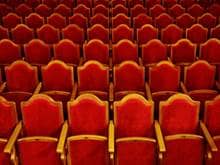Discover Your Power Color

By Pamela Harding
Are you feeling blue? Seeing red? Looking green around the gills? Try a healthy dose of color therapy. It might be just the prescription you need!
Our ancestors believed that color held magical properties. It could be used to ward off evil spirits, attract good ones, and even heal the sick. While in this age of hard science and cool technology we may view such beliefs with skepticism, our fascination with color has taken on new forms. Biochemists, environmental and industrial psychologists, make-up experts, wardrobe consultants, and, of course, advertising pros have studied color and found how it affects mood, health, image, perception, even heart rate. Certain colors can prompt you to eat faster, perceive objects differently, and even make you spend more money.
Although babies are drawn most strongly to bright colors, and children often prefer solid, vibrant hues, adults tend to choose more subdued tints and shades of color: pink and rose or maroon instead of fire-engine red, for instance, or peach, melon or rust instead of bright orange. To surround yourself with what you feel comfortable is most important. Certain colors can ramp up your mood, but only if they appeal to you. If they don't, they can do the opposite.
Red

Blood pressure, respiration, and muscle tension all increase on initial exposure to red. But, this jazzy hue also boosts spirits and stimulates creativity, conversation, and theappetite (which is why it is used in many restaurants). Red is also a popular color in casinos—people are more likely to gamble in a red environment than in, say, a blue one. Rooms with a lot of red feel warmer, heavier, and time seems to pass more slowly in them. Red may increase passion, but also aggression, anger, and restlessness—it's probably not the best choice of color for a bedroom. In clothingred conveys energy, power, and leadership, but can also signal romance and sensuality, depending on the garment.
An interesting note: when you have two objects of identical shape and weight, one red and one blue, most people will think the red one is heavier. (Might be one reason to rethink that red wardrobe! On the other hand, red accents could perk up your image.)
Orange

Like the edible fruit, orange is associated with health and well-being. Eye-catching, stimulating, exciting, and mood elevating, the color decreases irritability. Like red, it boosts appetite, but it will stimulate people to eat and run—hence the popular orange in many fast-food restaurants. Generally, orange conveys a sense of youth, quickness of mind and body, and is perceived as a warm and friendly color. An orange accent on a plate makes food look more appealing and lighter tints on walls or clothing flatter the complexion. Peach and melon are good colors for living rooms and dining areas. People who wear orange are seen as cheerful, emotional, communicative, enthusiastic, and fun.
Yellow

Vibrant yellow, bright and easily visible, is a great color to wear on dull, dark, or rainy days to add a little sunshine to your life. (It's also a good color to wear after dark if you're walking along busy streets.) The color projects love, light, warmth, and wealth, enhances communication, learning, mood, and energy level.
Generally, yellow combats gloom and fatigue. It opens up or brightens rooms, and pale tones are good choices for classrooms; warm tones good for play areas and living rooms. It's the most visible choice of background color for signs (with black lettering). People who wear yellow are perceived as sunny, intelligent, warm, and compatible. So wear gold (also in jewelry) or yellow when you're asking for a raise.
Green

The color of money, but also balance, harmony, and control, green exudes prosperity and well-being. It increases the ability to concentrate, while reducing muscular tension and stress.Refreshing and restorative, green is an ideal room color for sedentary or monotonous tasks—a good color for learning and doing. Rooms feel cooler and fresher. Turquoise and light green are good choices for kitchens, since they make room temperatures feel cooler and time and tasks seem to pass more quickly. Wear green to give the impression that you feel in control. It's a good color to wear if you're trying to keep the peace, mediate, or generate team spirit.
Blue

Blue hues lower blood pressure, respiration, and pulse and convey a sense of peace, serenity, and tranquility. Blue objects tend to feel lighter than they are. A pale blue bedroom creates a light, airy atmosphere and is likely to create a peaceful, restful environment that helps lull you to sleep. Rooms feel cooler, and time passes more quickly. Blue is also a good formal color for living rooms. However, choose the hue wisely, because it can also be depressing in bathrooms or dining areas, making people's complexions look gray. In clothing, “true” blue is an American favorite. Wear blue to inspire trust and loyalty, encourage communication, and convey a sense that you belong.
Violet

Violet hues suggest something unusual and superior. Associated with high spirituality, violet can also convey somberness or solemnity, and may be interpreted as either uplifting or depressing. Good forprayer and meditation, the color has an otherworldly character. It's not generally a good color choice for walls, since large expanses disturb the eyes' ability to focus. Wear violet and you'll project unconventionality, nonconformity, and creativity. The color stands out in a crowd and may be associated with acute perception and deep insight.
No comments:
Post a Comment